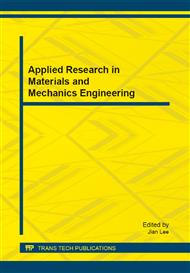[1]
L. Sorrentino, L. Liberatore, D. Liberatore and R. Masiani: Bull. Earthquake Eng. (2013), in press. doi: 10. 1007/s10518-013-9455-2.
Google Scholar
[2]
L. Sorrentino, L. Liberatore, L.D. Decanini and D. Liberatore: Bull. Earthquake Eng. (2013), in press. doi: 10. 1007/s10518-013-9519-3.
Google Scholar
[3]
M.C. Griffith, G. Magenes, G. Melis and L. Picchi: J. Earth. Eng. Vol. 7 (2003), p.141. doi: 10. 1142/S1363246903000997.
Google Scholar
[4]
L. Sorrentino, R. Masiani and L.D. Decanini: Struct. Eng. Mech. Vol. 22 (2006), p.293.
Google Scholar
[5]
L. Sorrentino, R. Masiani and M.C. Griffith: Struct. Eng. Mech. Vol. 29 (2008), p.433.
Google Scholar
[6]
O.A. Shawa, G. de Felice, A. Mauro and L. Sorrentino: Earthquake Engng. Struct. Dyn. Vol. 41 (2012), p.949. doi: 10. 1002/eqe. 1168.
DOI: 10.1002/eqe.1168
Google Scholar
[7]
L. Sorrentino, S. Kunnath, G. Monti and G. Scalora: Eng. Struct. Vol. 30 (2008), p.2140. doi: 10. 1016/j. engstruct. 2007. 02. 021.
Google Scholar
[8]
N.T.K. Lam, J.L. Wilson and G.L. Hutchinson: Bull. New Zealand Natl. Soc. Earthq. Eng. Vol. 28 (1995), p.179.
Google Scholar
[9]
M.C. Griffith, N.T.K. Lam, J.L. Wilson and K.T. Doherty: J. Struct. Eng. -ASCE Vol. 130 (2004), p.423. doi: 10. 1061/(ASCE)0733-9445(2004)130: 3(423).
DOI: 10.1061/(asce)0733-9445(2004)130:3(423)
Google Scholar
[10]
A.A. Costa, A. Arêde, A. Penna and A. Costa: Earthquake Engng. Struct. Dyn. Vol. 42 (2013), p.2297. doi: 10. 1002/eqe. 2327.
Google Scholar
[11]
M.A. ElGawady, Q. Ma, J.W. Butterworth and J. Ingham: Earthquake Engng. Struct. Dyn. Vol. 40 (2011), p.375. doi: 10. 1002/eqe. 1025.
DOI: 10.1002/eqe.1025
Google Scholar
[12]
S.J. Hogan: Proc. R. Soc. Lond. A. Vol. 439 (1992), p.35. doi: 10. 1098/rspa. 1992. 0132.
Google Scholar
[13]
D. Liberatore and G. Spera, in: I tessuti urbani di Ortigia. Un metodo per il progetto di conservazione, edited by G. Scalora, chapter 9, Ente Scuola Edile Siracusana (2003).
Google Scholar
[14]
G.W. Housner: B. Seismol. Soc. Am. Vol. 53 (1963), p.403.
Google Scholar
[15]
L. Sorrentino, O. AlShawa and L.D. Decanini: Bull. Earthquake Eng. Vol. 9 (2011), p.1617. doi: 10. 1007/s10518-011-9291-1.
Google Scholar
[16]
L. Sorrentino, R. Masiani and S. Benedetti, in: 2008 Seismic Engineering International Conference Commemorating the 1908 Messina and Reggio Calabria Earthquake, AIP Conference Proceedings, 1020 (PART 1), edited by A. Santini and N. Moraci, AIP, Melville, NY (2008).
DOI: 10.1063/1.2963733
Google Scholar
[17]
F. Peña, F. Prieto, P.B. Lourenço, A. Campos-Costa and J.V. Lemos: Earthquake Engng. Struct. Dyn. Vol. 36 (2007), p.2383. doi: 10. 1002/eqe. 739.
DOI: 10.1002/eqe.739
Google Scholar


